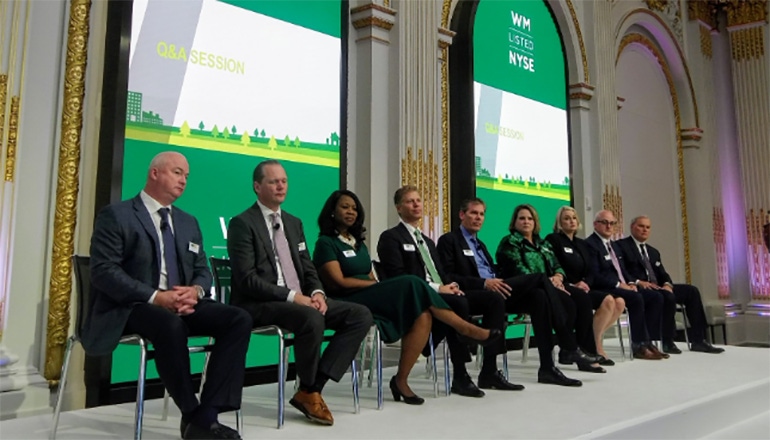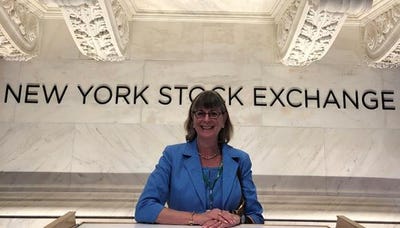In this month’s edition of Business Insights, we summarize the key messages and highlights of Waste Management’s Investor Day.

Waste Management (WM) held its first Investor Day in nearly a decade at the New York Stock Exchange on May 30. All the members of WM’s senior leadership team presented. In this month’s edition of Business Insights, we summarize the key messages and highlights of the day.
People First and a Sustainable Future
A key theme to emerge from the day was that management, led by CEO Jim Fish, has established a “People First” culture, and Waste Management intends to be an employer of choice. The underlying belief is that if employees are happy, they will better serve the customer, which ultimately will result in increased shareholder value. Given the aging demographics within the industry and the nationwide shortage of drivers and technicians, employee satisfaction is of paramount importance to combat costly turnover as well. Tamla Oates-Forney, senior vice president and chief human resources officer, noted the recent decrease in WM’s turnover rate, particularly among employees of less than one year, demonstrating that this effort is bearing fruit. She also outlined efforts to broaden the hiring pool, particularly among women, veterans and the overlooked and underserved. The infusion of technology is making WM a more attractive place to work, particularly for women.
Fish noted that the U.S. lacks a clear sustainability leader, and that this is a void that WM, with its premier brand, is in an optimal position to fill. Various speakers detailed WM’s success in converting its fleet to compressed natural gas (CNG)-powered vehicles (60 percent of routed trucks by year end 2019), closing the loop between renewable natural gas (RNG) plants at its landfills to fuel in its trucks and investing in advanced recycling technologies as evidence of the company’s leading sustainability efforts. Fish also noted that WM intends to judiciously invest more in its brand to further its sustainability leadership, though he emphasized that sustainability must make both environmental and economic sense. Oates-Forney also noted that changing the company narrative from solid waste to sustainability would also aid recruitment, particularly among millennials.
Going Digital
The increasing integrated use of technology and advanced data analytics was also a key thread that wove throughout all the presentations during the day. Nikolaj Sjoqvist, senior vice president and chief digital officer (a newly created position), detailed a number of the company’s initiatives on this front—some designed to decrease operating costs and others designed to “delight the customer” and thus enhance revenues. On the cost side, the company has launched “M100,” which enables frontline managers to improve labor efficiency throughout the day. WM also launched e-commerce and digital self-service platforms, such that WM customers can engage with the company using their channel of choice as well as increase the ease of doing business with WM. Ultimately, this should result in call center savings as well, as the company averages 12 million calls annually at an average cost of $8 per call. The company’s Smart Truck initiative is designed to both reduce costs and identify missed or potential revenue opportunities.
A Network That Cannot Be Replicated and a Recession-resistant, Recurring Revenue Stream
Chief Operating Officer John Morris kicked off the operations presentations, detailing WM’s geographic position and asset network, both collection and post-collection, that arguably cannot be replicated. WM has the best positioned landfills in 16 of the top 20 metropolitan statistical areas. He also presented new data from Waste Business Journal that forecasts a decline in landfill capacity over the next five years, after nearly 20 years of relative stability in remaining airspace, which should work to further WM’s competitive advantage in the future as it has been able to maintain its remaining airspace of 40 years. Morris highlighted WM’s diverse customer base, with a high proportion of recurring revenue, which he said creates recession resistance. He also noted the increasingly sophisticated metrics that WM is employing to manage the business before turning the presentation over to the two heads of field operations.
Collection Savings, Higher Return on Landfills and Profitable Recycling
Senior Vice President of Field Operations Steve Batchelor focused on the collection operations. After detailing the size and characteristics of the fleet and safety and service improvements, he spoke to the CNG conversion progress within the fleet and how it has resulted in lower fuel and maintenance costs, less miles driven and a 16 percent reduction in greenhouse gas emissions. He also outlined a timeline of projected cost savings, building on the company’s successful Service Delivery Optimization program, with the M100 initiative forecast to generate $75 million in savings by 2021, while dynamic routing is projected to result in savings of another $75 million by 2025.
Senior Vice President of Field Operations Tara Hemmer focused on post-collection. She detailed the closed loop RNG system WM is pursuing at its landfills, whereby landfill gas is processed and ultimately converted into fuel for the CNG fleet. These projects have quick paybacks and high returns. She also spoke to the Internet of Things within landfills that Sjoqvist’s team is developing, with automated connected sensors and pumps for monitoring and handling landfill gas and leachate, among other things. All these initiatives are designed to lower the costs, extract more value and ultimately raise the returns on the very capital-intensive landfill business. She also touched on the Materials Recovery Facility (MRF) of the Future currently under construction in Chicago, which is estimated to lower labor costs by 40 percent. Over the next three to five years, similar projects are targeted in eight to 10 markets. Increasing use of technology, changing the recycling business model to fee-for-service, educating customers and collaborating with consumer product companies to create demand for recycled content is WM’s multipronged approach to return recycling to greater profitability.
Driving Higher Organic Growth—Generating Price and Volume Does Not Have to Be a Zero Sum Game
Senior Vice President and Chief Customer Officer Mike Watson talked about WM’s initiatives to grow revenues in a balanced and disciplined manner through service differentiation, also in conjunction with Sjoqvist’s team’s work. He noted six areas of focus with higher growth potential—small and medium-sized businesses, sustainability solutions, public sector, strategic accounts, manufacturing and industrial and energy and environmental services. He detailed how Smart Truck was identifying opportunities to increase service, which he identified as a $110 million to $115 million revenue opportunity by 2022. He then focused on two strategic segments in which WM is leveraging its unique asset base and deep domain expertise to grow revenues. The sustainability services segment has enjoyed a three-year compound annual growth rate of 25 percent, reaching $252 million in revenues last year. In the coal ash market, Watson noted that WM was looking at a pipeline of projects totaling more than $3.5 billion in opportunity. The key take-home message was with the use of data analytics to better understand the customer’s needs and desires combined with better leveraging of WM’s asset base (including its brand), growing price and volume does not have to be a trade-off—WM continues to forecast industry-leading volume growth while maintaining its pricing discipline.
An Eye to the Future
Chuck Boettcher, senior vice president and corporate development and chief legal officer, spoke about WM’s newly reconstituted corporate development group, which he took pains to emphasize was very different than WM’s past efforts to invest in alternative technologies—the group is focused on smaller dollar amounts invested, a lower risk profile and more of a focus on businesses connected to the core and projects that can be scaled more quickly. He profiled the Caterpillar partnership, which is currently piloting remote operation of landfill vehicles. That said, he also described WM’s $15 million investment in three venture funds, which provide WM the eyes and ears on potential new alternative or next generation technologies being developed worldwide.
Financial and M&A Update—Long-term Annual Growth Targets Unveiled
Chief Financial Officer Devina Rankin provided a financial profile and update as well as new information on the proposed Advanced Disposal Services (ADS) acquisition. First, she detailed WM’s impressive progress over the past four years on a number of fronts—revenue growth, EBITDA and EBITDA margins, free cash flow and free cash flow conversion and returns. She also reviewed the balanced and consistent capital allocation approach over the past three years, while highlighting the company’s strong balance sheet that enabled the proposed acquisition of ADS. With regard to the ADS transaction, the company posted an updated timeline, with the major new events including the recently completed debt offering to fund the deal and the HSR and ADS proxy filings. She also noted that there was significant interest in potential divestitures.
The deal is on track to close in the first quarter of 2020. Rankin then went on to reaffirm 2019 guidance (exclusive of costs/impacts associated with ADS), despite the fact that the recycled commodity market has again deteriorated from first quarter levels. Finally, she laid out annual growth targets through 2021 of 4 to 6 percent collection and disposal revenue growth and 5 to 7 percent operating EBITDA and free cash flow growth as a base case. Underlying assumptions included both yield and volume growth of around 2 percent plus and tuck-in acquisitions of roughly $100 million to $200 million annually. Management does see the opportunity to bend the EBITDA growth curve higher by 200 to 400 basis points, implying growth of 7 to 9 percent, with the upside potential stemming from further leveraging technology and above-expected mergers and acquisition activity.
Leone Young is the principal of LTY ERC, LLC, providing consulting and research services to, and conducting special projects for, the environmental services industry, primarily the solid waste sector.
About the Author(s)
You May Also Like




